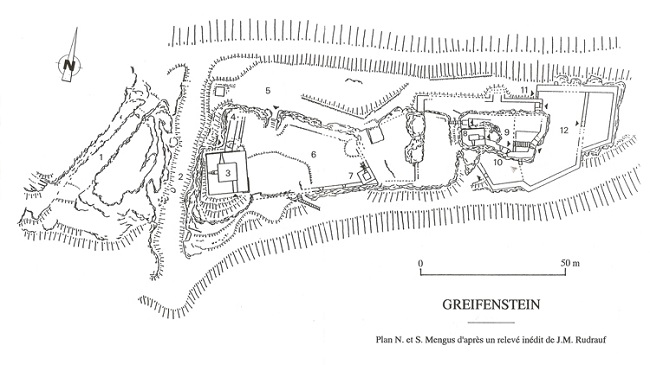
Location: Griffon Mais Forest, Saverne, Bas- Rhin department Map
Château de Greifenstein is a medieval castle ruin located in the commune of Saverne, in the Bas-Rhin department of the Grand Est region, northeastern France. Nestled in the Vosges Mountains, it forms part of a defensive chain of castles guarding the passage from the Alsace plain to Lorraine. The complex comprises two sections: Grand-Greifenstein (the older, western part) and Petit-Greifenstein (the younger, eastern part), separated by a rock-cut ditch, earning the nickname "Griffon Castle." Managed as state property and classified as a monument historique since 1898 by the French Ministry of Culture, the castle is a popular destination for hikers and history enthusiasts due to its panoramic views over the Zorn Valley and nearby castles like Haut-Barr and Grand-Geroldseck. Freely accessible, it remains in ruins with no active restoration as of August 2025, embodying the medieval heritage of Alsace.
Château de Greifenstein is situated at coordinates 48°44′9″N
7°20′3″E, on a wooded granite ridge at 360 meters altitude, west of
Saverne in the Northern Vosges. It overlooks the Zorn Valley, facing
Haut-Barr and the Geroldseck castles. The site is surrounded by dense
forests, valleys, and meadows, contributing to the Vosges massif’s
biodiversity. The nearby Ramsthal lake marks the start of access trails.
The terrain’s rugged elevation enhances its defensive design.
The
climate is temperate oceanic with continental influences, typical of
Alsace and the Vosges. Winters are cool, averaging 0–5°C in January with
frequent snow, while summers are mild to warm, averaging 20–25°C in
July. Annual precipitation ranges from 800–1,000 mm, spread evenly but
higher in the mountains, with fog and mist common. The elevated site is
slightly cooler than the Rhine plain below, with occasional strong
winds. As of August 2025, weather patterns remain stable, though climate
projections suggest increased rainfall variability by 2050.
The castle’s origins trace to the early 12th century, with
Grand-Greifenstein likely founded by Meribodo de Greifenstein, a knight
documented by 1156 with ties to the Ochsenstein family and the Bishop of
Strasbourg. Petit-Greifenstein was built later, likely in the late 13th
or early 14th century, expanding the defenses. By 1217, the Ochsenstein
lords held parts of the castle. In the 14th century, the Bishop of
Strasbourg became the suzerain, formalizing co-ownership through peace
agreements in 1401, 1440, and 1474. The Greifenstein family was
succeeded by the Hohenburger in 1450 and the Kirchheimer in 1482. Count
Palatine Louis de Deux-Ponts-Veldenz, brother of the bishop, controlled
Petit-Greifenstein. In 1470, enemies of Count Palatine Frederic briefly
occupied the castle, but it was returned to the bishop. By 1516, the
bishop owned both sections.
The castle deteriorated during the Thirty
Years’ War (1618–1648), likely already in decline beforehand. In 1670,
its stones were quarried for Cardinal-Bishop François Egon de
Furstenberg’s palace in Saverne. In 1675, Henri de La Tour d’Auvergne,
Viscount of Turenne, ordered its destruction to prevent military use.
Abandoned thereafter, it was classified as a historical monument in
1898, ensuring preservation efforts.
Reconstruction of Château de Greifenstein and its layout Map


Greifenstein is a dual-castle complex on a ridge, divided by a rock-cut ditch with a flanking tower. Grand-Greifenstein features Alsace’s largest keep, a 12th-century Romanesque square structure (13 meters per side) built from red sandstone with prominent bossages (protruding stones). Petit-Greifenstein includes a seigneurial keep and ruins of residential buildings. A restored cylindrical tower, possibly part of Grand-Greifenstein, stands centrally between the keeps. Historical texts from the 15th century mention a Saint-Vit vault, though its location is uncertain. The design integrates with the rocky terrain, using high walls and strategic positioning for surveillance. Local red sandstone and granite dominate, with remnants of embossments and narrow paths enhancing the medieval aesthetic.
As an uninhabited ruin, Château de Greifenstein has no direct economic activity but supports tourism in Saverne. The castle draws visitors to the Vosges, boosting local businesses through hiking trails, guided tours, and heritage initiatives. No commercial development occurs on-site, but the broader region benefits from tourism-related revenue, including accommodations and outdoor recreation. Preservation is state-funded, with no industrial presence.
The castle itself has no residents, being a ruin. Saverne, the host commune, has about 11,000 inhabitants as of 2022, within the Bas-Rhin department’s population of roughly 1.1 million. The area reflects Alsace’s bilingual heritage, with French and Alsatian German speakers. Seasonal tourism increases visitor numbers, but the site remains tranquil, appealing to those seeking history and nature.
Château de Greifenstein embodies Alsace’s medieval culture, tied to knightly families and episcopal power. It is part of the Route des Châteaux Forts d’Alsace, promoting educational tours on feudal architecture and Vosges defenses. Saverne’s festivals occasionally highlight regional history, though the castle hosts no events. As an open-air museum, it attracts school groups studying medieval France, with informational panels along trails providing context.
Key features include the 12th-century keep of Grand-Greifenstein, the rock-cut ditch, and the restored flanking tower, which offers sweeping views of Saverne, the Zorn Valley, Haut-Barr, Grand-Geroldseck, and the Saint-Vit chapel. The forested setting enhances hiking opportunities, with trails connecting to nearby castles like Ochsenstein. The panoramic terrace is a highlight for photographers and historians, showcasing the castle’s strategic position.
Access is via a 25-minute hike from the D132 road out of Saverne toward Lutzelbourg, following a blue-rectangle-marked path from the Ramsthal lake trailhead. The terrain is moderate. Saverne is reachable by the A4 highway and regional trains from Strasbourg (30 km) or Paris (about 2 hours via TGV to Strasbourg). No public transport serves the trailhead directly; cars or bikes are recommended.
As of August 2025, no significant restoration or development projects are reported for Château de Greifenstein. Managed by the state and maintained with help from local hiking groups like Club Vosgien, the site focuses on preservation and trail upkeep. Regional efforts in Alsace emphasize sustainable tourism, but Greifenstein remains unchanged, with no new infrastructure or excavations. Free access continues, aligning with France’s heritage conservation goals.